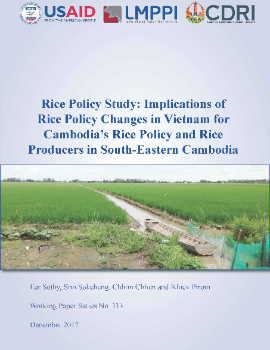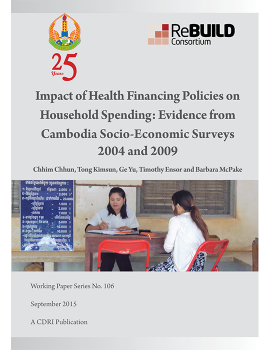CHHIM Chhun
Former Research Fellow
Email : NA


There are many studies about rice production in Cambodia, but none focus on the geographical location of rice production, particularly in the south-eastern provinces of Prey Veng, Takeo and Svay Rieng. Farmers in these areas produce mainly low-value rice (IR504) most of which is exported as wet paddy to Vietnam. The Vietnamese government recently d...

This paper looks at the effect of labour movement on farm mechanisation in rural Cambodia. The study focuses on labour movement from on-farm towards off-farm jobs, and uses investment in agricultural machinery as a proxy for farm mechanisation. Statistics show that in recent years there has been a huge outmigration from rural areas. This has had si...

We use the 2004 and 2009 Cambodia Socio-Economic Surveys to measure the impact of user fees, health equity funds, the government health subsidy scheme, vouchers and various combinations of these policies on household health spending. Employing a difference-indifferences estimator and a two-part model, we find that health equity funds and vouchers h...

This paper estimates the incidence and intensity of catastrophic health payments and their impoverishment effects and identifies the sources of catastrophic payments by using the nationally representative household survey, the Cambodia Socio-Economic Survey conducted in 2004, 2007, 2009, 2010 and 2011 by the National Institute of Statistics. We fin...


Cambodia has been identified as one of the most vulnerable countries to climate change, given the predicted changes in temperature and precipitation, the share of labor in agriculture, and the country’s low adaptive capacity due to widespread poverty. In this study, we use climate data from four general circulation models (GCMs) to evaluate the imp...



Cambodia’s economy is largely based on the agricultural sector and this sector is the main water user in Cambodia (Wokker et al. 2011a: 1-3). Several studies acknowledge that wet season rice farming is crucially important for livelihoods. With such farming being historically dependent on rainfall, the majority of lowland farmers grow just one crop...

This paper presents the main findings of the Policy Coherence for Agriculture and Rural Development study. Policy Coherence for Development (PCD) is about making sure that policies for sector development do not contradict or undermine one another and that as far as possible, policies are complementary and create synergy. In practice, it is abo...

